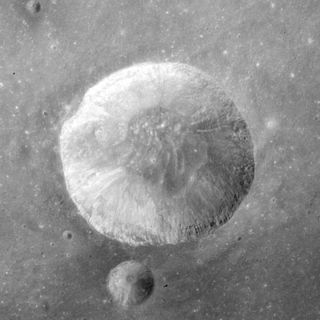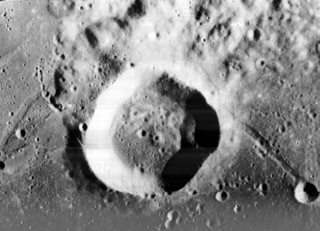
Bianchini is a lunar impact crater that lies along the northern Jura Mountains that ring the Sinus Iridum, in the northwestern part of the near side of the Moon. It was named after Italian astronomer Francesco Bianchini. The impact of this crater near the edge of the Jura Mountains deposited some material into the Sinus Iridum floor.

Archytas is a lunar impact crater that protrudes into the northern edge of Mare Frigoris. To the northwest is the comparably sized crater Timaeus, and the smaller Protagoras lies in the opposite direction to the southeast. Further to the southwest, beyond the opposite edge of the mare, is the dark-floored crater Plato.

Brunner is a lunar impact crater that is located along the eastern limb of the Moon, to the southeast of the Mare Smythii. At this location the crater is viewed from the edge, and so it is not possible to see much detail from the Earth. The visibility of this formation is also affected by libration. The crater lies to the southwest of the walled plain Hirayama, and to the east of the elongated crater Houtermans.

Carmichael is a lunar impact crater that is located along the eastern edge of the Sinus Amoris, in the northeastern quadrant of the Moon's near side. Its diameter is 20 km. It was named after American psychologist Leonard Carmichael. It lies within a couple of crater diameters south-southwest of the smaller crater Hill. Further to the east-northeast is the prominent crater Macrobius. Carmichael was designated Macrobius A before being given its current name by the IAU.

Demonax is a lunar impact crater near the southern limb of the Moon. This location makes the crater difficult to observe due to foreshortening. The crater is also illuminated at a very low angle, when it is in the sunlit side. Demonax lies just to the north of the crater Scott, one of the south polar formations. To the north-northwest is Boguslawsky.

Carver is a lunar impact crater that is located on the far side of the Moon, due east of the walled plain Van der Waals. To the northeast is the crater Rosseland, and to the south-southeast lies Kozyrev.

Carnot is a large crater in the northern part of the Moon's far side. It intrudes into the southern rim of the huge walled plain Birkhoff. To the west-southwest of Carnot is the crater Paraskevopoulos.

Coriolis is a lunar impact crater that is located on the far side of the Moon. The crater floor is bisected by the lunar equator, and it lies about three crater diameters northwest of the crater Daedalus.

Drebbel is a small lunar impact crater named after Cornelius Drebbel that is located to the northeast of the large walled plain Schickard, in the southwestern part of the Moon. Further to the northeast is the Lacus Excellentiae and the small crater Clausius.

Chaplygin is a large lunar impact crater that lies on the far side of the Moon. It is located to the southeast of the huge walled plain Mendeleev, about midway between the craters Schliemann to the northeast and Marconi to the southwest. It is about the same size as Albategnius on the near side.

Chang Heng is a lunar impact crater that is located on the Moon's far side. It lies less than one crater diameter to the northeast of the walled plain Fleming. The rim of this crater is somewhat eroded, with a pair of small craters along the northern rim and tiny craters along the south and east edges. The interior floor contains a small, concentric crater that is about one third the diameter of Chang Heng. The crater is named after Chinese astronomer Zhang Heng.

Congreve is a lunar impact crater that is located on the far side of the Moon relative to the Earth, and lies across the lunar equator. It lies to the west-northwest of the massive walled plain Korolev. To the southeast is the crater Icarus, and due north is Zhukovskiy.

Fourier is a lunar impact crater that is located in the southwestern part of the Moon's near side, just to the southeast of the crater Vieta. To the northeast is the Mare Humorum. The rim of this crater is roughly circular, but appears oval when viewed from the Earth due to foreshortening.

Fraunhofer is a lunar impact crater that is located just to the south-southwest of the walled plain Furnerius, in the southeastern part of the Moon. This crater appears foreshortened when viewed from the Earth, and is actually nearly circular.

Donner is a lunar impact crater on the far side of the Moon. It is located just to the northeast of the Mare Australe, behind the southeastern limb of the Moon. During favorable librations this part of the lunar surface can be brought into view of the Earth, but the site is viewed from the edge and so not much detail can be seen.
Eijkman is a lunar impact crater that is located on the far side of the Moon's southern hemisphere. It lies about a half crater diameter to the southeast of the larger crater Lemaître. To the south-southwest is the crater Crommelin, and to the northeast is Fizeau.

Emden is a lunar impact crater that is located in the northern hemisphere on the far side of the Moon. It is named after Jacob Robert Emden (1862-1940).

Fersman is a large lunar impact crater on the Moon's far side. It lies to the east of the crater Poynting, and west-northwest of Weyl. To the south is the huge walled plain Hertzsprung.

Firsov is a lunar impact crater on the far side of the Moon. It is located to due south of the crater Lobachevskiy, and to the northwest of Abul Wáfa. The circular rim of this crater has a small outward bulge along the southern edge, and smaller bulges along the western side. The inner walls have slumped to form talus piles along the base. The low-albedo interior floor is nearly level and featureless.

Frost is a lunar impact crater that is attached to the southern rim of the walled plain Landau, and lies on the far side of the Moon. Just to the east is Petropavlovskiy, and to the northeast along the edge of Landau is Razumov. The crater Douglass is located less than a crater diameter to the west-southwest.
























